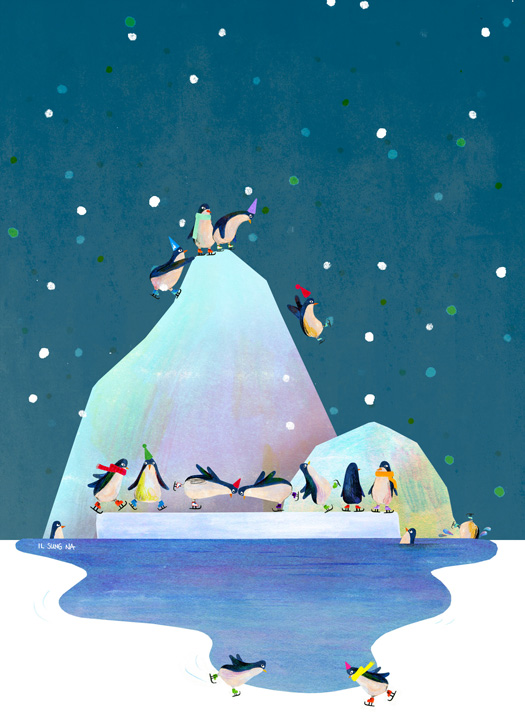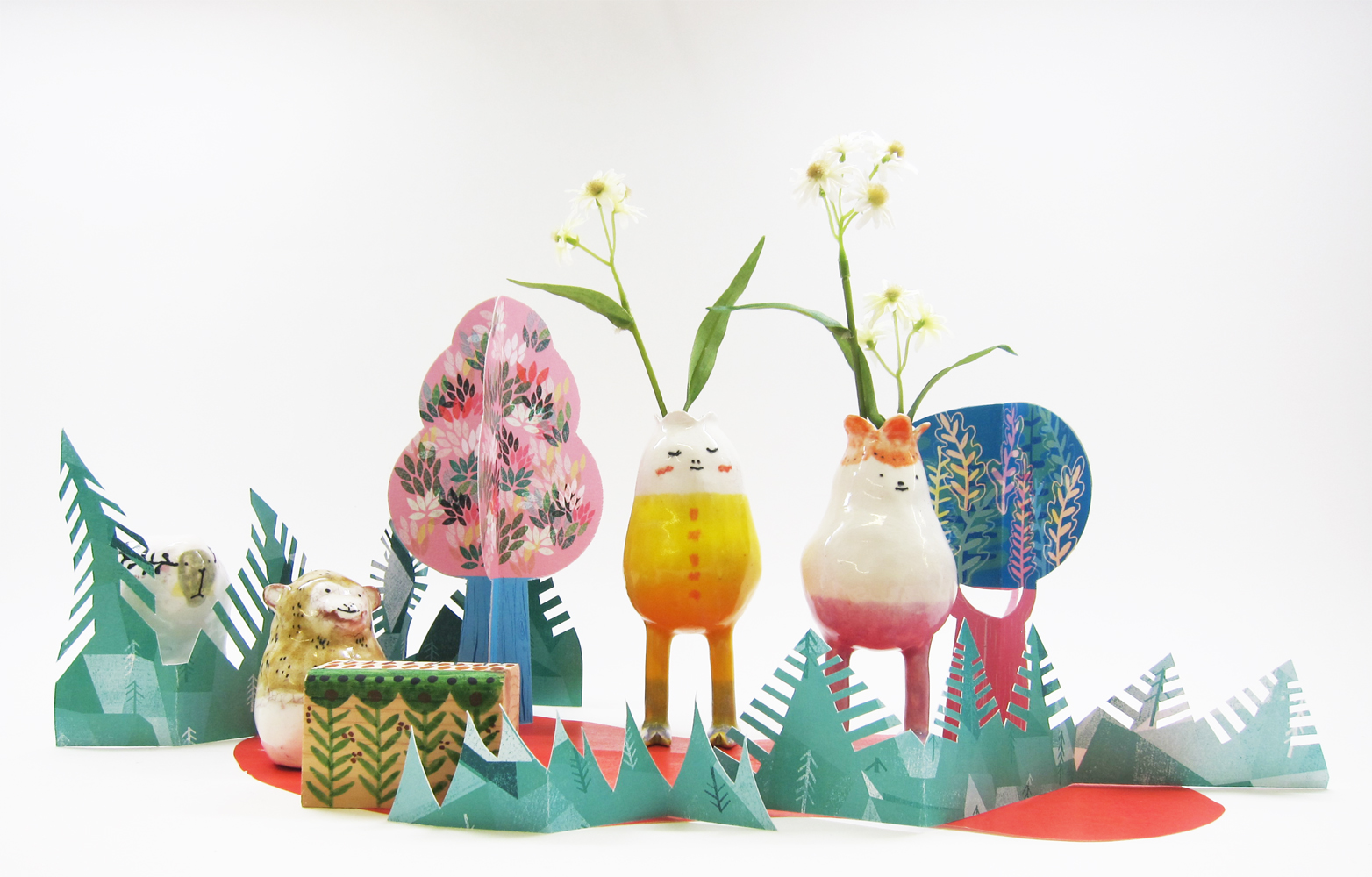This year the KCAI Illustration Web Team is launching a few new features one of which will focus on our faculty, all of whom are working illustrators/artists. Our first feature is on the newest member of our faculty team, Assistant Professor Il Sung Na. This summer, Il Sung and his wife relocated from New Jersey to Kansas City. We were able to catch up with him recently and ask him a few questions about this new position, his first impressions of the Midwest and what he loves about being an illustrator and educator.
When did you first realize that you wanted to be an illustrator?
When I first got into an art college, I only knew that I like drawings but nothing more than that. Then I met a friend who loved children’s picture books and we spent a lot of time together in bookstores. I was fascinated by how picture books can tell stories with illustrations. Text and illustration are telling the same story but different ways. In a picture book, illustrations extend, clarify, complement, or take a place of words. And as a visual person and also a non-English speaker, this was a perfect way to tell my stories without saying/writing too many words. Since then, I wanted to make picture books with my stories and that’s exactly what happened.
What has been the most challenging aspect to your craft and profession?
Keeping a creative routine. Although I love creative processes, sometimes it gives a hard time to go through. I enjoy the process of thumbnail sketches, character drawings and colors, however I always have a hard time to come up with ideas and write stories. So I spend more or less half potion of times from a whole creative process to find good ideas/stories. There are also lots of thumbnails and crossed out lines (there are lots of revisions involved), but I have to keep drawing/making/creating until I get it right. It’s a kind of routine we (as creative people) cannot get away. Productivity comes at a price.
Who has been your mentor? What makes you different from them and the same?
I had a professor at my foundation who discovered my talent of drawings and lead me to the right direction. He emphasized students to draw from life. Observation drawing was the key with his assignments.
And there are more! Although I haven’t met them, I learned a lot of things from their works. I know this may not what you meant, but this is how I learned and found my ways of working.
I made my first dummy book when I was a sophomore level, but I did not know anything about a picture book. So I used picture books as my mentors. The Rabbit by John Marsden (author) & Shaun Tan (illustrator) and Slow Loris by Alexis Deacon. I read the books over and over, exam layouts, compositions and flows in the books. I really enjoyed the ways they tell a story. Simple text but just enough, and illustration does the rest of the job. Shaun Tan and Alexis Deacon are still among my favorites, and I was influenced by their works very heavily from the beginning. Maybe that’s why all of my picture books have simple texts, only one or two sentences on each spread. Maybe because I still believe that illustration can tell more stories than texts.
There are many artists/illustrator who I got inspirations from, such as Kveta Pacovska, Quentin Blake, Brian Wildsmith and John Birningham. And of course, there are a lot more because I keep adding artists to my lists.
My recent discovery of Javier Zabala, Spanish illustrator, made me to try watercolor after being away from it for many years because I did not enjoy using it. At first I tried to make a drawing like his, then I modified the ways of working with my tastes, adding color pencils and marker pens.
What are you most excited about with this position?
Well, what’s the most rewarding is when I know that students make some progress in their works in any way. I am no difference, but I want to see students prove me wrong in a way, too. I try to be honest but all feedback and critique are from my perspective and we all have different experiences and different opinions. Sometimes we agree but sometimes we disagree. I think that’s the moment that students really jump in and dig deeper, and show what they can do. I wait for that moment to happen. And once it happens, I appreciate and enjoy the moment.
What are your first impressions of the Midwest?
Green, hot summer, kind people and Antiques!
What part of your career best prepared you for educating?
This is a tricky question indeed. Because I am still learning things from others and I guess this is on going process which never ends.
When I was in college, I had good professors and great studio mates throughout years. But I did not get specific feedback for picture books as there were no one who had experiences in the children’s picture book industry. I learned many things while I worked with publishers and year after year I gained more experiences that I want to share with students who want to be an illustrator (or storyteller). When I looked back my student years I sometimes wondered if I had some experienced people around, I would have learned more efficiently? Maybe or maybe not. But that made me consider sharing my experiences.
Also working with clay is one of my strength. Nowadays it’s not strange at all that illustrators work with different media like ceramics. I have started working with clay knowing nothing and wanted to get away from my daily creative routine. I just wanted to have some fun, make a lot of junks. However, it certainly added to my artistic repertoire and enriched my range as a visual creator and a storyteller. It was a kind of ‘AHA’ moment. And I want students to try some different materials because we never know what we are capable with until we try.
7. What career did you think you would have when you were a child?
Architect! My dad was an architect and I lived in a house that he built when I was a kid. Although I had a different path to study industrial engineering when I was in Korea, I was fortunate to pursue my parent that I had a passion for drawing.
I still dream about design or draw my future house in the future though. Maybe one day I will do.
What keeps you inspired? Do you have a mantra or philosophy to your work?
A lot of things really. It can be from conversations with people, in exhibitions, watching documentary films or anything touches my curiosity. Sometimes it starts from a word or an image. I keep my eyes and ears wide open you can observe so many things. Always ask to myself how and why. I also keep recording ideas on my sketchbooks otherwise I will forget them after seconds.
"Keep It simple" has been my motto. Sometimes less is better. I understand that we want to show so many things at once but showing one at a time makes it easier to understand.
"If there is something to steal, I steal." -Pablo Picasso
This is the quote that I have been following since I was a student. I don’t mean to steal physical things or other artists’ ideas. What I mean by that is learning from others.
There is always something to learn. I learned good compositions from photograph, movie scene or painting and use it my works. I learned how to write a story by reading other people’s story. It’s not copying other people’s work. You need to digest it in you well and make it yours. We are creative people but it’s really hard to create something from nothing.
BIG thanks to Il Sung for taking the time to answer our questions. Welcome to KCAI, Il Sung! To see more of Il Sung's work be sure to visit his website.





